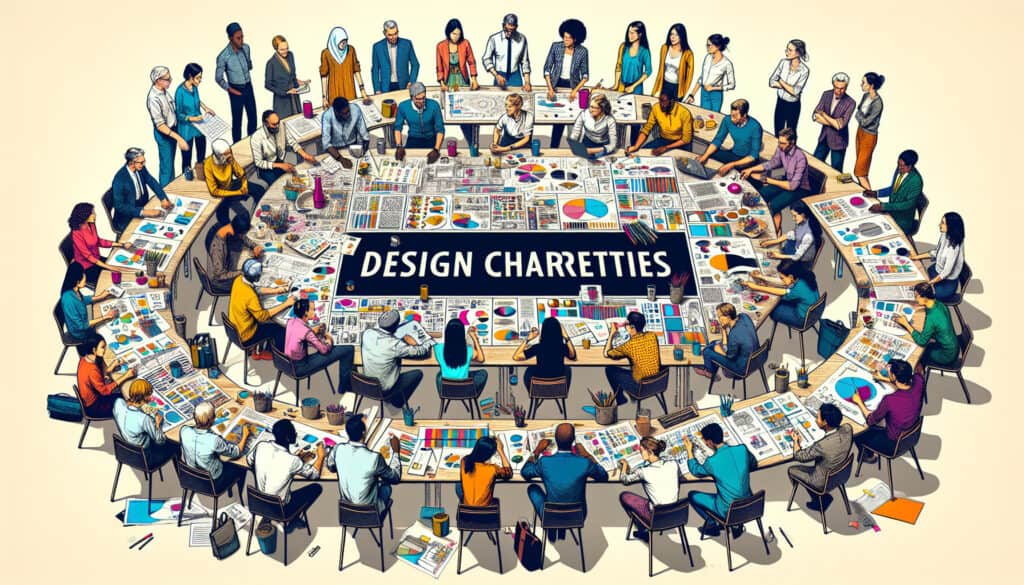Un atelier de conception intense et collaboratif où les parties prenantes (concepteurs, clients, utilisateurs, experts) se réunissent pour faire un brainstorming et développer une solution à un problème. problème de conception dans une période concentrée.
- Méthodologies : Ingénierie, Ergonomie
Charrettes de conception

Charrettes de conception
- Méthodologie Agile, Remue-méninges, Collaboration interfonctionnelle, Pensée conceptuelle, Conception centrée sur l'humain, Développement itératif, Prototypage, User-Centered Design
Objectif :
Comment il est utilisé :
- Une charrette est une session rapide et pratique au cours de laquelle de multiples idées sont proposées et esquissées. L'objectif est de générer et de converger rapidement vers une direction de conception par le biais d'une collaboration rapide.
Avantages
- Favorise la collaboration et met toutes les parties prenantes sur la même longueur d'onde ; génère un grand nombre d'idées et une solution de conception viable très rapidement ; crée un consensus et une appropriation partagée.
Inconvénients
- Peut être épuisant et stressant en raison de sa forte intensité ; nécessite un animateur compétent pour maintenir la session sur la bonne voie ; la qualité du résultat dépend de la qualité des participants.
Catégories :
- Idéation, Conception de Produits, Gestion de projet
Idéal pour :
- Co-création rapide d'une solution à un problème de conception dans le cadre d'un atelier court, intensif et collaboratif.
Design charrettes are frequently utilized in urban planning, architecture, and product development, bringing together diverse stakeholders such as designers, engineers, clients, and users throughout the different phases of a project, particularly during ideation and concept refinement. These intensive workshops often occur early in the design process, allowing rapid ideation and synthesis of varied perspectives that can enrich the final product. For example, in the context of urban redevelopment, a charrette may include local residents, planners, and environmental experts to collaboratively envision community spaces that meet ecological, social, and economic needs. This methodology provides a structured yet flexible format for brainstorming solutions, often utilizing sketching and visual tools to communicate ideas swiftly, which can lead to breakthrough innovations that might not arise in standard meetings. The participatory nature encourages engagement and can significantly reduce the time spent on revisions and misunderstandings later in the project by aligning different viewpoints early on. Organizations like the American Institute of Architects promote this approach for its ability to cultivate community involvement and garner a sense of shared investment in the outcomes, creating a platform where everyone can contribute, thus leading to a more centré sur l'utilisateur design solution. Each session typically culminates in a tangible output or preliminary design direction that serves as a reference point for subsequent phases of development, reinforcing the commitment to collaboration and shared ownership among all participants, which is crucial for successful outcomes in interdisciplinary projects.
Principales étapes de cette méthodologie
- Définir clairement le problème de conception et s'assurer que tous les participants le comprennent.
- Encourager la génération d'idées par des séances de brainstorming et d'esquisses.
- Organiser les participants en petits groupes pour des discussions et des idées ciblées.
- Animer des présentations rapides des idées de chaque groupe afin d'échanger des points de vue.
- Recueillir les réactions de l'ensemble du groupe sur les idées présentées.
- Identifier des modèles et des thèmes communs parmi les idées générées.
- Affiner et hiérarchiser les idées en vue d'un développement ultérieur.
- Converger vers une orientation de conception choisie qui reflète la contribution collective.
Conseils de pro
- Incorporer des outils de prototypage rapide pendant la session pour visualiser les concepts en temps réel, ce qui améliore la compréhension et l'engagement.
- Attribuez des rôles spécifiques aux participants, tels que l'animateur, le scribe et le dessinateur, afin d'optimiser les contributions et de maintenir l'organisation de la session.
- Utiliser alternativement les techniques de pensée divergente et convergente, en encourageant l'émergence de nouvelles idées avant d'en arriver à des solutions réalisables.
Lire et comparer plusieurs méthodologies, nous recommandons le
> Référentiel méthodologique étendu <
ainsi que plus de 400 autres méthodologies.
Vos commentaires sur cette méthodologie ou des informations supplémentaires sont les bienvenus sur le site web de la Commission européenne. section des commentaires ci-dessous ↓ , ainsi que toute idée ou lien en rapport avec l'ingénierie.
Contexte historique
1949
1950
1950
1960
1960
1960
1960
1940
1950
1950
1958
1960
1960
1960
1960
(si la date est inconnue ou n'est pas pertinente, par exemple "mécanique des fluides", une estimation arrondie de son émergence notable est fournie)















Articles Similaires
Questionnaires sur les troubles musculo-squelettiques
Tests à plusieurs variables (MVT)
Analyse de régression multiple
Systèmes de capture de mouvement
Méthode MoSCoW
Test de la médiane de Mood